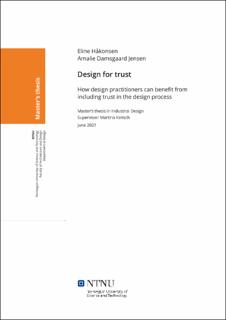| dc.description.abstract | Tillit er en grunnleggende, men skjør, drivkraft i samfunnet - og en viktig bidragsyter til blant annet innovasjon, samarbeid, informasjonsdeling og økonomisk utvikling. Det er mange insentiver for å utforske hvordan tillitsfull oppførsel kan oppmuntres systematisk, påvirkes eller “dultes”. Mange disipliner som psykologi, sosiologi, økonomi og sosialpsykologi har diskutert emnet bredt, men fortsatt kan det virke som om skjæringspunktet mellom tillit og design ikke er undersøkt og utforsket grundig nok. Denne oppgaven tar derfor sikte på å gi designutøvere en mer generell forståelse av hvordan tillit kan oppnås når de designer løsninger til komplekse utfordringer, hvor tillitsproblemer er tilstede. Videre argumenter vi for at designere som er i stand til å inkludere tillit og bringe det inn i virksomheten, har en fordel, både fra et økonomisk og sosialt perspektiv.
For å styrke skjæringspunktet mellom designteori og praksis, vil avhandlingen først diskutere sammenhengen mellom de vitenskapelige teoriene om tillit og hvordan de kan brukes i designpraksisen. Videre vil vi skissere hvordan tillit kan re-evalueres og styrkes gjennom designvalg og designaktiviteter. Til slutt presenterer vi et omfattende designerverktøy, Trustspiration.com, som bruker teoretisk innsikt for å påvirke og styrke tilliten til (digitale) produkter, tjenester eller virksomheter. Verktøyet, og som er en plattform gjort tilgjengelig for alle, er utviklet gjennom brukerinnvolvering med EGGS Design som eksterne partnere. For å samle trådene avslutter vi med å diskutere læringsutbyttet ved å kombinere designforskning og praksis, samt hva de potensielle effektene og fordelene av å ”designe for tillit” kan være fra et mikro- og makroperspektiv. | |
| dc.description.abstract | Trust is a fundamental, yet fragile driver in society and a key contributor to innovations, collaborations, information sharing and economic development, amongst others. There are many incentives to explore how trustworthy behaviour can be systematically encouraged, influenced or nudged, and many disciplines such as psychology, sociology, economy and social psychology have discussed this topic widely. Still, the connection between trust and design is yet to be scrutinized and explored thoroughly. This thesis aims to provide design practitioners with a more general understanding of how trust can be earned when dealing with complex design challenges, where trust issues are bound to be involved. Moreover, we argue that designers who are able to include trust and bring it into business have an advantage, both from an economic and social perspective.
To strengthen the cross-pollination of design theory and practice, the thesis will first discuss the connection between the scientific theories of trust and how they can be applied in the design practice. Further, we will sketch out how trust can be theoretically revisited and practically strengthened through design choices and design activities. Lastly, we present a comprehensive designer tool, Trustspiration.com, that employs theoretical insights for design practice, to influence trust in (digital) products, services or businesses. The tool, which is an open-source platform made accessible to all, has been developed by employing participatory design methods with EGGS Design as external partners. Conclusively, we discuss the learning experiences on combining design research and -practice, as well as potential effects and benefits of “designing for trust” from a micro and macro perspective. | |
